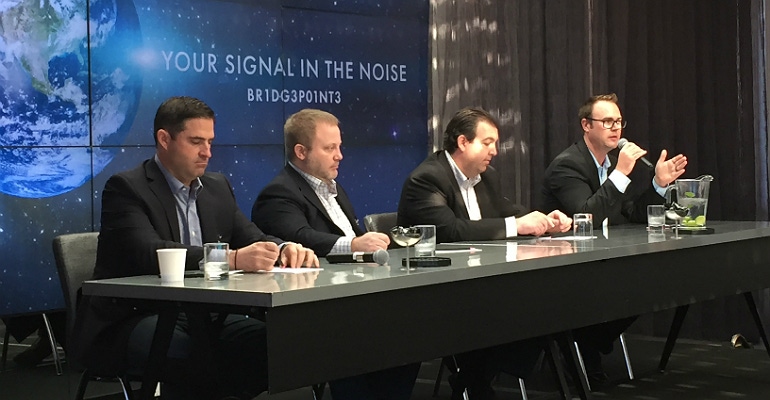One IT leader says MSPs, colocation and public cloud are "melding" together.

Businesses entrust their workloads to a variety of platforms. Colocation, on-premises data centers, public cloud. Choices, choices — so what’s the best option?
One data-center executive remarks that, “We’re living in a hybrid world,” meaning that partners must weave together the best solutions from each world for the customer.
At its two-day rebranding event in San Francisco this month, Bridgepointe Technologies featured a cloud panel focused on the impact that hyperscale cloud providers are having on colocation and private-cloud businesses.
Engineers with IBM, Synoptek, Equinix and CoreSite shared their experiences crafting solutions customers and their data.
Synoptek
Ryan Ribary works as a senior solutions architect for Synoptek, the Irvine, California-based managed services provider. He shared the use case of an advertising technology company that came to Synoptek and Equinix.
This customer was born in AWS, which proved to be insufficient on its own.

Ryan Ribary
Ryan Ribary
“What they discovered was that the cloud didn’t solve all things,” Ribary said. “They needed a hybrid approach. Hybrid truly is what answers most of the questions, because cloud doesn’t solve everything. On-site data center doesn’t solve everything.”
Businesses and the partners that look after them benefit from nuance. For Ribary, the best IT decision cost-effectively uses the “right application in the right place at the right time for the right reason.”
“That gives you thought leadership,” he said. “That allows you to provide strategy.”
And while it might be obvious, it’s worth noting that public clouds offer different strengths and weaknesses. Partners and customers should see the value of choice.
“It really is important that there are things AWS does better than everybody else. IBM or Azure or Oracle, and being able to the right one at the right place at the right time somewhere on Earth, is what is important.”
Synoptek used this approach to help decrease the company’s bidding latency to zero milliseconds, and it proved to be a game-changer. The company’s chief technology officer later told Ribary that his employees “can suck now,” because they no longer needed to code solutions to get around the latency.
The CTO was joking, but the point stands.
“As crass as that was, that’s a great phrase,” Ribary said. “My guys can suck, and they still rock.”
IBM
Todd Brockdorf, an IBM cloud solutions engineer for North America, says most cloud providers provide x86-based workloads for platforms like Windows, Linux or VMware. But x86 doesn’t account for everything.
“The challenge with enterprise clients today is that their workloads are not just X86-based workloads. They have other stuff — stuff being a technical term, of course,” Brockdorf joked. “They have other stuff that needs to go somewhere.”
Brockdorf says IBM used a hybrid approach to help a client on a disaster-recovery platform. The company’s disaster recovery for x86, Windows and Linux platforms went into the IBM Cloud, but there remained AIX-based “power” workloads that didn’t work best with traditional cloud services. IBM collocated those workloads. Managed services wrapped around all of the workloads.
“When you use all those three working together, that’s how you can help your clients build a cohesive cloud strategy, especially for disaster recovery,” Brockdorf said.
CoreSite
Brian Eichman works as business development manager for CoreSite, the data-center provider. He agrees with Ribary on the dominance of hybrid cloud.
“There is a really good melding going on between colocation, managed service providers and public cloud providers,” Eichman said. “The level of sophistication of the enterprise is rapidly evolving.”
Eichman says public-cloud providers have targeted data-center companies like CoreSite and Equinix. The first phase of public cloud was enterprises using it on top of internet, but eventually they “realized that it kind of stinks.” Latency and reliability are a problem, and the internet affords neither “enterprise-grade connectivity” nor “production-grade workload.”
“It worked for maybe a DR or test/dev environment, but [not] when I’m ready to run production-grade workloads and try[ing] to preserve that WAN-like type of experience. What public-cloud providers are telling the enterprise is, ‘Leave your closets. Leave your on-site data centers and put it in our cloud.’ There are some real benefits to doing that.”
Businesses have beefed up their IT staffs in order to take care of legacy infrastructure that is not going away anytime soon, according to Eichman.
“We’re living in a hybrid world. The on-prem, the legacy applications and infrastructure [are] not going away anytime tomorrow or in the next five years. That stuff will live on for a variety of reasons. But how do I efficiently connect that legacy infrastructure into my public cloud providers or SaaS providers within the data center? That stuff is difficult.”
He noted that CoreSite does not operate its own managed-service practice. The company partners with more than 150 MSPs and systems integrators that work at its facilities. Their skill sets differ, from expertise in storage to security.
“You shouldn’t have to just choose one or the other, but you need choice within the data center,” he said. “That’s what we provide you.”
About the Author(s)
You May Also Like


